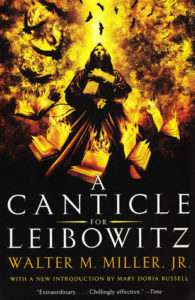 Canticle for Leibowitz is an acknowledged sci-fi classic that appears on everybody’s top 50 list, so I read it. I was disappointed, mainly because the pace was too slow, the characters flat, and the story obvious. Not a winner.
Canticle for Leibowitz is an acknowledged sci-fi classic that appears on everybody’s top 50 list, so I read it. I was disappointed, mainly because the pace was too slow, the characters flat, and the story obvious. Not a winner.
Why is it a classic? Because it’s an interesting historical allegory of ambitious scope. It spans a period from about 1950 to beyond 3700 CE, some centuries after the nuclear holocaust (but not enough centuries, really, because enriched plutonium takes about ten thousand years to decay to safe levels).
Only a few Catholic monks survived. Civilization was completely lost, much as it was in Europe after the fall of Rome and the ensuing “Dark Ages” and then the Middle Ages, where the Church was virtually the only keeper of the intellectual flame. That’s a nice setup.
In Canticle, monks in the Utah desert conserve incomprehensible scraps of paper and circuit diagrams from the mid-20th century that survived in a bunker. They have no idea what any of it means. Of course we know it involved military technology that led to the apocalypse.
The middle section of Canticle is set around 3100 CE, when a “renaissance” begins. Scholarship has progressed to the point where a smart-guy character is capable of interpreting the ancient artifacts, just as in the actual Renaissance, humanists re-discovered the teachings of the ancient Greeks.
Finally, in a third section set around 3700 CE, civilization and technology have recovered (in only 600 years!) to the point where spaceships are flying again and societies are building nuclear weapons again. Will the whole cycle repeat?
Miller wrote the sections as three different novellas published separately in 1950’s pulp sci-fi magazines. Later they were stitched together into this book, and it reads like that. The three sections are disjointed in writing style, characters, and plot.
A unifying thread is the ritual, practice, and belief systems of the Catholic Church, the rock that endures through history, along with its strangely non-evolving Latin. Lots of untranslated passages of Latin appear in the text, which most readers will just have to skip. (Ironically, only ten years after this book was published, the Catholic Church went off Latin).
The tsunami of quotidian monkish practices and commentary was dead weight for me. Maybe Catholicism is scintillating stuff for someone steeped in the religion, but otherwise, it sinks the book like an anchor.
Are the basic ideas of the book, the cyclical nature of history and the depressingly hopeless view of human nature, mind-benders? I wonder if they weren’t commonplace ideas even in 1959 when the book came out.
In any case, the novel stands as an example of psi-fi, because it is fundamentally a commentary about human nature. The science and technology of nuclear war are only background ideas. Though I wasn’t thrilled with the book, I’m happy to claim a “classic” for psi-fi.
Miller, Walter M., Jr. (1959/1986). A Canticle for Leibowitz. New York: Harper-Collins.